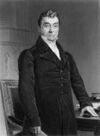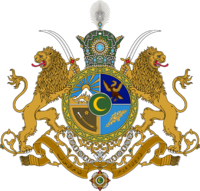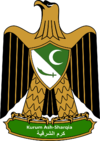Treaty between Çakaristan and Kurum Ash-Sharqia: Difference between revisions
No edit summary |
(→Background: link) |
||
| Line 19: | Line 19: | ||
== Background == | == Background == | ||
The royal houses of Çakaristan and Kurum Ash-Sharqia are related through Kurum Ash-Sharqian princess consort [[ | The royal houses of Çakaristan and Kurum Ash-Sharqia are related through Kurum Ash-Sharqian princess consort [[Elisabeth Asara des Vinandy]], who is a half sister of Shahanshah [[Jaaguzan]], born Frederik Harald des Vinandy. The families maintained warm contacts. After the consolidation of the Çakar Empire, both governments deemed the time to be ripe for a formal friendship treaty. | ||
== State visit == | == State visit == | ||
Revision as of 07:05, 30 May 2023
|
Treaty of Kurum Ash-Sharqia | |
| Treaty between Çakaristan and Kurum Ash-Sharqia | |
| Signing ceremony | 1712-23 at Agra |
| Islamic Diwan | positive |
| Al-Majlis Al-Watani | 1712-30 |
| Sultan | 1713-02 |
| Executive Decrees | |
| Parties | |
The Treaty of friendship and cooperation between the Çakar Empire and the Sultanate of Kurum Ash-Sharqia was signed and ratified in 1712 AN.
Background
The royal houses of Çakaristan and Kurum Ash-Sharqia are related through Kurum Ash-Sharqian princess consort Elisabeth Asara des Vinandy, who is a half sister of Shahanshah Jaaguzan, born Frederik Harald des Vinandy. The families maintained warm contacts. After the consolidation of the Çakar Empire, both governments deemed the time to be ripe for a formal friendship treaty.
State visit
A formal state visit was organized from 11.XI.1712 AN tot 12.XI.1712 AN. A large delegation of 300 politicians, business men and people from the cultural sector joined the Sultan and Grand Vizier Kawthar Saleh to Agra. In between the official ceremonies, contacts were made and various contracts were signed.
Day 1
The Sultan and his entourage were received on the forecourt of the Red Fortress. There, 21 gun salutes were performed from the wall. The Sultanic Couple being welcomed by the Shahanshah and his wife at the Red Fortress. The Sultan was invited to inspect the guard of honor. Under military display, the honour guard stood at attention. The sultan walked past the honour guard, across the green runner. After the press photo, the Sultanic couple was escorted across the bridge into the Red Fortress. A brief tour was given and lunch was prepared.
The Sultanic couple was transferred by carriage to the Nation Park. This park is adjacent to the Palace of the Nation, where the Çakari Congress resides. There stands the National Monument, which commemorates the war dead including those of Sylvanian National Awakening, Çakaristan's war of independence. As is customary during state visits to Çakaristan, the Sultanic Couple laid a wreath at the National Monument.
They also attended the Çakari Congress. The Sultan would not give a speech to the Majlis al-Nuwaab because he is not a head of government. Kawthar Saleh, Grand Vizier of Kurum Ash-Sharqia, did give a speech to the Majlis al-Nuwaab. The Sultan and Sultana were guests of honor and attended the session in which the Grand Vizier spoke. The first day of the state visit concluded with a state banquet at the Red Fortress, where the Shahanshah and the Sultan each gave a speech.
Day 2
The grand viziers of both nations had gathered at the Rani Mahal. A ceremony was held there, during which the treaty was signed. Kawthar Saleh had thanked the Çakari initiative for the Convention on Civil Aviation the day before. In the Red Fortress, the heads of state awarded orders to each other:
 To Jaaguzan, Shahanshah of Çakaristan, was awarded the Grand cordon of the Order of As-Saif.
To Jaaguzan, Shahanshah of Çakaristan, was awarded the Grand cordon of the Order of As-Saif. To Salah Ad-Din Al-Lusirni, Sultan of Kurum Ash-Sharqia, was awarded the First Class of the Order of Çakar.
To Salah Ad-Din Al-Lusirni, Sultan of Kurum Ash-Sharqia, was awarded the First Class of the Order of Çakar.
That afternoon, the Sultanic Couple visited the Akbar Mahal, the mausoleum of Akbar. The impressive building also provided the backdrop for a photo opportunity. The Sultanic Couple posed with the iconic building in the background.
The Sultanic Couple and the grand vizier met again at the building, where Kurum Ash-Sharqia's embassy will be housed. To the sounds of the national anthem, the flag was hoisted and the Sultan cut the ribbon.
Day 3
A trade summit was held, where businesses and governments from the two nations could meet. New technologies were presented and all kinds of agreements were signed. In the gardens of the Red Fortress, the green tent was set up and on the lawn all kinds of tables and lounges. The extended Vinandy family was invited for a family reunion. The only formal thing here was the family photo taken. Otherwise, the atmosphere was relaxed. Rank and file were let loose and heads of state romped with the children.
The Shahanshah had offered the Sultan and his half-sister a concert. She and the adults of the Vinandy family attended:
Text
TREATY OF FRIENDSHIP AND COOPERATIONBETWEEN
THE ÇAKAR EMPIRE
AND
THE SULTANATE OF KURUM ASH-SHARQIA
His Majesty, Jaaguzan, Shahanshah of Çakaristanand
His Majesty, Salah Ad-Din, the Sultan of Kurum Ash-Sharqia
desire for a diplomatic relationship and good understanding between them, underpinning further friendship between their respective countries, have agreed to the following articles of agreement:Article I – Peace and friendship
There shall be a firm and perpetual state of peace and friendly relations between His Majesty, the Shahanshah of Çakaristan and His Majesty, the Sultan of Kurum Ash-Sharqia, between Their Heirs or Successors, and between the Çakar Empire and the Sultanate of Kurum Ash-Sharqia, in this treaty the High Contracting Parties, and between their Citizens, without discrimination.Article II - Sovereignty and territorial integrity
Each High Contracting Party shall respect the independence, sovereignty and territorial integrity of the other party. The High Contracting Parties shall continue to develop and consolidate the relations of sincere friendship, good neighbourliness and comprehensive cooperation existing between them on the basis of the aforesaid principles as well as those of equality and mutual benefit.Territorial integrity includes the territory of a High Contracting Party to the extent acknowledged and published by the Micronational Cartography Society. The territory extends 24 kilometres from the baseline coast of the High Contracting Party. Including the localities where the coastline is deeply indented and cut into, or if there is a fringe of islands along the coast in its immediate vicinity, the method of straight baselines joining appropriate points may be employed in drawing the baseline from which the breadth of the territorial sea is measured.
The reserve zone of a High Contracting Party extends 360 kilometres from the baseline coast. The economic and environmental resources within this zone belong fully to that High Contracting Party. In special situations where the territorial waters or the reserve zone of the High Contracting Parties would overlap, the line of separation will be drawn along the midpoint between the baseline of each High Contracting Party.
Article III - Airspace
The High Contracting Parties agree to sign and ratify the Convention on Civil Aviation of the Micras Treaty Organisation within two Norton years after the ratification of this treaty.Article IV – Diplomatic mission
The High Contracting Parties will maintain regular contacts with each other on major international problems affecting the interests of both of their countries and governments by means of meetings, and exchanges of views between their leading statesmen, visits by official delegations and special envoys of the governments, and through diplomatic channels.The High Contracting Parties will make an embassy available for each other. For the embassy, associated grounds, associated vehicles, leading statesmen, visits by official delegations, special envoys of the governments and ambassadors, diplomatic immunity applies.
Each High Contracting parties recognizes and respecst the procedures of acceptance by the ambassador, by handing over a letter of credence, which is addressed from one head of state to the other asking to give credence.
Article V - Recognition of bureaucracy
Each High Contracting Party gives to the other full faith and credit to all public acts, records, contracts and judicial proceedings in the field of civil law, including records and documents on marriage, property, titles, death and inheritance, in as much as any act, record, document, contract, proceeding is done according to the law.Article VI - Interpretation
Any difference of interpretation of any Article or Articles of this Treaty which may arise between the High Contracting Parties will be settled bilaterally by peaceful means in a spirit of mutual respect and understanding.Article VII - Ratification
This Treaty enters into force upon its signature and ratification by Both High Contracting Parties in accordance with their respective domestic procedures.Article VIII - Repeal
The High Contracting Parties parties may repeal this treaty on the condition of a notice of one Norton year.Signed on 12.XI.1712 AN at Agra:
For the Çakar Empire:
Dervish Çelebi
Grand Vizier of Çakaristan
For the Sultanate of Kurum Ash-Sharqia:
Kawthar Saleh
Grand Vizier




